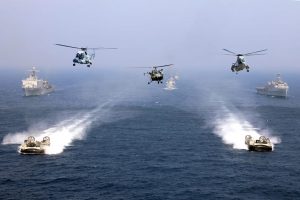[ad_1]
Flashpoints | Diplomacy | Security | South Asia
A January 19 news article by a well-connected Indian journalist calls recent claims to question.

U.S. Navy landing craft air cushions, helicopters lead a formation with the USS Germantown and INS Jalashwa during exercise Tiger TRIUMP, 2019.
Credit: Flickr/U.S. Indo-Pacific Command
Buried amid the media excitement around U.S. President Joe Biden’s inauguration on January 20 was an extraordinary article in a leading Indian newspaper, written by its executive editor. The day before, on January 19, the Hindustan Times’ Shishir Gupta – a journalist widely known for his close connections with the current government in New Delhi, and India’s national security establishment – reported on how the Indian government sees the crisis in Ladakh playing out in the near future as temperatures begin to rise there. (Hint: not so well, according to some in the Indian defense and security circles.)
But, the real import of the article was in its revelation of deep-seated anxiety about Biden – and what he may portend for the future of China-U.S. relations – within sections of the Indian establishment, at least among those who chose to reveal their views to Gupta. According to these anonymous sources, the “Chinese moves [in Ladakh] may also be influenced by the tone and tenor of the incoming Joe Biden administration towards Beijing” – and that Biden administration may effectively grant “recognition of China as the other superpower,” inching toward a “G-2,” thus complicating matters for India.
Readers may recollect that a China-U.S. “G-2” under a Democrat in the White House remains a persistent worry for many in New Delhi – and something the U.S. side is keenly aware of. As an example: In a June 12, 2009 memo to then Secretary of State Hillary Clinton, then-undersecretary of state for political affairs (and now Biden’s nominee for the directorship of the Central Intelligence Agency) Bill Burns, wrote: “[Indian] oped warriors and chattering class have been predicting an American ‘downgrading’ of the relationship in our pursuit of a ‘G-2” with China.”
But the live munitions in Gupta’s article were elsewhere: “According to senior officials familiar with the national security deliberation… New Delhi is not dependent on the US for handling the PLA,” Gupta wrote, going on to add in no uncertain terms: “The fact is that the US has indeed increased Indian awareness of the Indo-Pacific by providing access to information, the same cannot be said about the Ladakh stand-off [emphasis added].”
This is as wholesale a repudiation of assertions made by senior U.S. officials as they come. Recall that the outgoing U.S. ambassador to India, Kenneth Juster, speaking at a think tank event on January 5, had confirmed that the United States had indeed been involved in the Ladakh crisis, albeit refusing to give out specifics. “Our close coordination has been important as India confronts, perhaps on a sustained basis, aggressive Chinese activity on its border,” Juster had said. Coincidentally or not, that very day (now former) U.S. National Security Advisor Robert O’Brien had declassified the U.S. Strategic Framework for the Indo-Pacific, which noted that the United States, as part of its Indo-Pacific strategy, needs to “offer support to India through diplomatic, military and intelligence channels to help address continental challenges such as the border dispute with China…” (At the time of writing this piece, the document has been removed from the White House website, as spring cleaning starts early this year in Washington.)
While it is perhaps unproductive to speculate on why Gupta’s sources said what they did – without knowing who they are – one possibility lies with the fact that the very public assertions by U.S. officials to the effect that it has teamed up with India to help it manage the China crisis have been perceived by many here as complicating matters when it comes to a resolution of the Ladakh standoff. The other – less charitable – possibility is that the Indian establishment seeks to signal Biden that it is not beholden to U.S. military assistance when it comes to dealing with the People’s Liberation Army on land – and that strategic autonomy lives on India.
[ad_2]
Source link